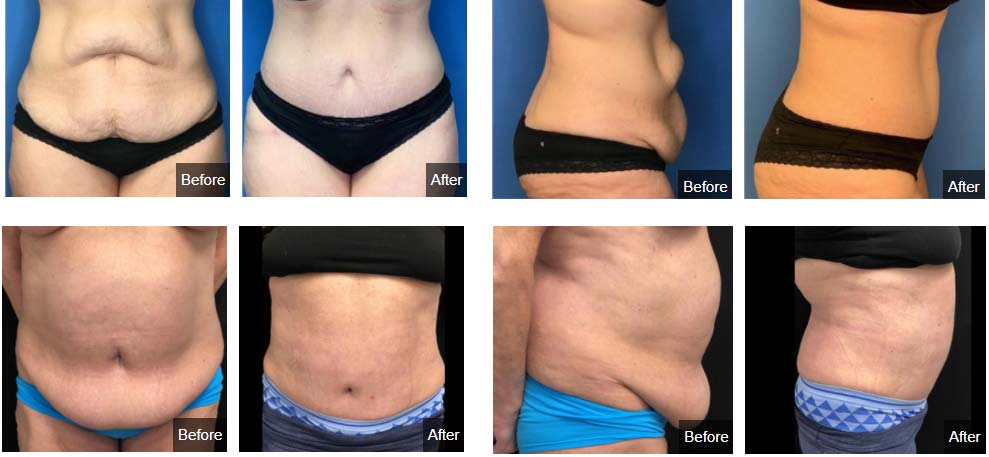A Flat Belly with Less Downtime: the Mini Tummy Tuck
The Revolutionary “Mini Tummy Tuck”
The results of tummy tuck surgery can be amazing – providing one’s abdominal area with a toned, firm appearance. Tummy tucks are especially popular among women after childbirth, but the effects of a tummy tuck can be reaped by anyone. A tummy tuck is also a great way to tighten up one’s physique after significant weight loss. But since the traditional tummy tuck surgery is relatively invasive, many patients ask if similar results be attained through something less invasive.
In this article, board certified Troy, MI area plastic surgeon Dr. Ali discusses what is known as the Mini Tummy Tuck: a procedure that provides comparable skin tightening results, while being less invasive than traditional tummy tuck surgery.
Traditional Tummy Tuck Surgery
To understand what makes the Mini Tummy Tuck so remarkable, we must first understand its traditional, more invasive predecessor. Tummy tuck surgery generally involves creating an incision in the abdomen area that runs all the way from one side to the other. This allows for the removal of excess skin. The abdominal skin is then pulled tight to create a smooth, toned stomach area.
In addition to removing and tightening loose skin, tummy tuck surgery may also include the removal of some unwanted fat. A traditional tummy tuck is also capable of repairing and restructuring the muscles of the treatment area, something especially beneficial from women whose abdominal muscles have separated following pregnancy.
At AMAE Plastic Surgery, we believe it is important for our patients to have an equal understanding of both the traditional tummy tuck surgery procedure as well as a Mini Tummy Tuck. While there are a number of similarities between the two, they are ultimately two very different procedures. Board certified Troy, MI area plastic surgeon will gladly help you determine which procedure is right for you during your consultation.
How a Mini Tummy Tuck Works
A full tummy tuck is performed to rejuvenate the entire upper and lower abdominal area. However, a Mini Tummy Tuck is performed to surgically tighten just the lower abdomen – through a less extensive procedure than a traditional tummy tuck. A Mini Tummy Tuck is ideal for correcting loose skin as well as stretch marks below the belly button. Patients at our Troy, MI area area plastic surgery practice regularly chose the Mini Tummy Tuck to get rid of what is sometimes called a “pouch” or “paunch” … that stubborn, saggy, lower belly.
During a Mini Tummy Tuck, loose abdominal muscles may be tightened through a single small incision, made just above the pubic mound. Then, after then removing any excess skin, the abdominal wall will be restored to a flat, smooth appearance. When completely healed, the scar from a Mini Tummy Tuck will be incredibly small, appearing as simply a thin, horizontal line, no longer than a few inches in length. So, any scarring is much smaller in a Mini Tummy Tuck.
While a great many people have left our Troy, MI area area practice thrilled with the results of their Mini Tummy Tuck, we must reiterate that the procedure is not right for everyone. The results of a Mini Tummy Tuck are not identical to traditional tummy tuck surgery. Excess skin, fat, or stretch marks located above the belly button cannot be treated with a Mini Tummy Tuck. Furthermore, as the name suggests, a Mini Tummy Tuck is capable of removing a much smaller amount of skin or fat than a full tummy tuck.
Benefits of a Mini Tummy Tuck
With that in mind, the less invasive nature of the Mini Tummy Tuck makes the procedure highly desirable among patients visiting our Troy, MI area facility. While offering a small size of incision, the Mini Tummy Tuck is capable of producing some truly impressive results. And when a patient chooses to include liposuction in their Mini Tummy Tuck treatment plan, select areas of unwanted fat can be removed as well!
A Mini Tummy Tuck takes less time to perform than full tummy tuck surgery, and is an all-around less invasive procedure. Mini Tummy Tuck patients also enjoy a shorter and easier period of recovery, in addition to the smaller scar. And since a Mini Tummy Tuck entails physically removing excess abdominal skin as well as fat, the results of the procedure are frequently much more pronounced than those of non-surgical treatments like CoolSculpting.
Mini Tummy Tuck – Troy, MI area
In addition to full traditional tummy tuck surgery and mini tummy tucks, we also offer several less invasive procedures for getting a flatter, toned tummy, including liposuction, CoolSculpting and amazing new Profound skin tightening.
To learn more about the Mini Tummy Tuck, or other tummy toning procedures, contact AMAE Plastic Surgery for a consultation. Then come and relax in our Troy, MI area office while we help you look and feel better than ever.



